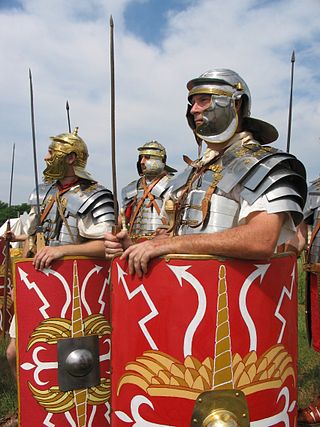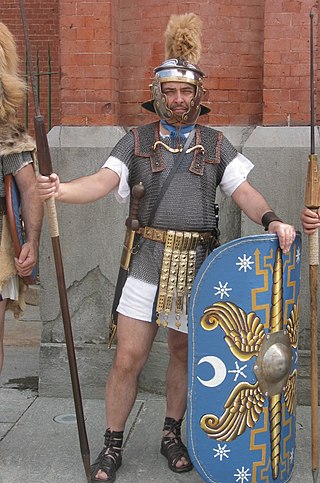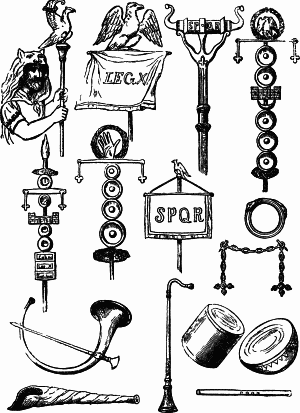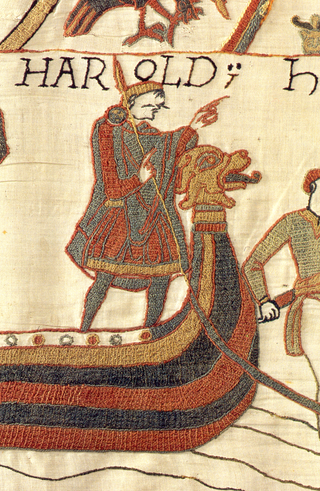
The lorica segmentata, also called lorica lamminata, or banded armour is a type of personal armour that was used by soldiers of the Roman army, consisting of metal strips fashioned into circular bands, fastened to internal leather straps.

The Roman legionary was a citizen soldier of the Roman army. These soldiers would conquer and defend the territories of ancient Rome during the late Republic and Principate eras, alongside auxiliary and cavalry detachments. At its height, Roman legionaries were viewed as the foremost fighting force in the Roman world, with commentators such as Vegetius praising their fighting effectiveness centuries after the classical Roman legionary disappeared.

A military uniform is a standardised dress worn by members of the armed forces and paramilitaries of various nations.

The falx was a weapon with a curved blade that was sharp on the inside edge used by the Thracians and Dacians. The name was later applied to a siege hook used by the Romans.

Imperial Japanese Army uniforms tended to reflect the uniforms of those countries who were the principal advisors to the Imperial Japanese Army at the time.

The lorica hamata is a type of mail armor used by soldiers for over 600 years from the Roman Republic to the Roman Empire. Lorica hamata comes from the Latin hamatus (hooked) from hamus which means "hook", as the rings hook into one another.

An optio, was a position in a centuria (century) of a Roman army similar to that of an executive officer. The main function of an optio was as an optio centuriae, the second-in-command of a century, although there were many other roles an optio could adopt.

Byzantine dress changed considerably over the thousand years of the Empire, but was essentially conservative. Popularly, Byzantine dress remained attached to its classical Greek roots with most changes and different styles being evidenced in the upper strata of Byzantine society always with a touch of the Hellenic environment. The Byzantines liked colour and pattern, and made and exported very richly patterned cloth, especially Byzantine silk, woven and embroidered for the upper classes, and resist-dyed and printed for the lower. A different border or trimming round the edges was very common, and many single stripes down the body or around the upper arm are seen, often denoting class or rank. Taste for the middle and upper classes followed the latest fashions at the Imperial Court.

A manica or cheires by the Greeks was a type of iron or bronze arm guard, with curved and overlapping metal segments or plates, fastened to leather straps, worn by Roman gladiators called crupellarii, and later optionally by soldiers.

The lorica squamata is a type of scale armour used by the ancient Roman military during the Roman Republic and at later periods. It was made from small metal scales sewn to a fabric backing. No examples of an entire lorica squamata have been found, but there have been several archaeological finds of fragments of such shirts and individual scales are quite common finds—even in non-military contexts.

The uniforms of the British Army currently exist in twelve categories ranging from ceremonial uniforms to combat dress. Uniforms in the British Army are specific to the regiment to which a soldier belongs. Full dress presents the most differentiation between units, and there are fewer regimental distinctions between ceremonial dress, service dress, barrack dress and combat dress, though a level of regimental distinction runs throughout.

Roman military personal equipment was produced in large numbers to established patterns, and used in an established manner. These standard patterns and uses were called the res militaris or disciplina. Its regular practice during the Roman Republic and Roman Empire led to military excellence and victory. The equipment gave the Romans a very distinct advantage over their barbarian enemies, especially so in the case of armour. This does not mean that every Roman soldier had better equipment than the richer men among his opponents. Roman equipment was not of a better quality than that used by the majority of Rome's adversaries. Other historians and writers have stated that the Roman army's need for large quantities of "mass produced" equipment after the so-called "Marian Reforms" and subsequent civil wars led to a decline in the quality of Roman equipment compared to the earlier Republican era:
The production of these kinds of helmets of Italic tradition decreased in quality because of the demands of equipping huge armies, especially during civil wars...The bad quality of these helmets is recorded by the sources describing how sometimes they were covered by wicker protections, like those of Pompeius' soldiers during the siege of Dyrrachium in 48 BC, which were seriously damaged by the missiles of Caesar's slingers and archers.
It would appear that armour quality suffered at times when mass production methods were being used to meet the increased demand which was very high the reduced size cuirasses would also have been quicker and cheaper to produce, which may have been a deciding factor at times of financial crisis, or where large bodies of men were required to be mobilized at short notice, possibly reflected in the poor-quality, mass produced iron helmets of Imperial Italic type C, as found, for example, in the River Po at Cremona, associated with the Civil Wars of AD 69 AD; Russell Robinson, 1975, 67
Up until then, the quality of helmets had been fairly consistent and the bowls well decorated and finished. However, after the Marian Reforms, with their resultant influx of the poorest citizens into the army, there must inevitably have been a massive demand for cheaper equipment, a situation which can only have been exacerbated by the Civil Wars...

The modern Irish Army uniform is based on the layer principle, and is designed to provide soldiers in the Irish Army with the right degree of protection for any operational environment.
The Imperial helmet-type was a type of helmet worn by Roman legionaries. Prior to the Empire, Roman Republican soldiers often provided their own equipment, which was passed down from father to son. Thus, a variety of equipment, from different eras was present in the ranks. Even as the professional Imperial army emerged, and short-term service citizen soldiers became rare, useful equipment was never discarded. So when the improved Imperial helmet appeared, it replaced what remained of the very old Coolus type, which was largely superseded at the time by improved versions of the Montefortino helmet type, which continued to serve alongside it for a time. This constituted the final evolutionary stage of the legionary helmet (galea).

Clothing in ancient Rome generally comprised a short-sleeved or sleeveless, knee-length tunic for men and boys, and a longer, usually sleeved tunic for women and girls. On formal occasions, adult male citizens could wear a woolen toga, draped over their tunic, and married citizen women wore a woolen mantle, known as a palla, over a stola, a simple, long-sleeved, voluminous garment that modestly hung to cover the feet. Clothing, footwear and accoutrements identified gender, status, rank and social class. This was especially apparent in the distinctive, privileged official dress of magistrates, priesthoods and the military.

The lorica plumata also known the lorica hamata squamatque was a set of Roman armor. The name lorica plumata translates to feathered cuirass. It was named for its a feathered appearance due to the feather-like scales called plumes attached to oval shaped rings.

Anglo-Saxon dress refers to the clothing and accessories worn by the Anglo-Saxons from the middle of the second century to the eleventh century. Archaeological finds in Anglo-Saxon cemeteries have provided the best source of information on Anglo-Saxon costume. It is possible to reconstruct Anglo-Saxon dress using archaeological evidence combined with Anglo-Saxon and European art, writing and literature of the period. Archaeological finds have both supported and contradicted the characteristic Anglo-Saxon costume as illustrated and described by these contemporary sources.

The Eastern Roman army refers to the army of the eastern section of the Roman Empire, from the empire's definitive split in 395 AD to the army's reorganization by themes after the permanent loss of Syria, Palestine and Egypt to the Arabs in the 7th century during the Byzantine-Arab Wars. The East Roman army was the continuation of the Late Roman army of the 4th century, until it gradually transformed into what is now called the Byzantine army from the 7th century onwards.
The Medieval period in England is usually classified as the time between the fall of the Roman Empire to the beginning of the Renaissance, roughly the years AD 410–1485. For various peoples living in England, the Anglo-Saxons, Anglo-Danes, Normans and Britons, clothing in the medieval era differed widely for men and women as well as for different classes in the social hierarchy. The general styles of Early medieval European dress were shared in England. In the later part of the period, men's clothing changed much more rapidly than women's styles. Clothes were very expensive and both the men and women of lower social classes continued also divided social classes by regulating the colors and styles these various ranks were permitted to wear. In the early Middle Ages, clothing was typically simple and, particularly in the case of lower-class peoples, served only basic utilitarian functions such as modesty and protection from the elements. As time went on the advent of more advanced textile techniques and increased international relations, clothing gradually got more and more intricate and elegant, even with those under the wealthy classes, up into the renaissance.

The Imperial Roman army was the military land force of the Roman Empire from 27 BC to 476 AD, and the final incarnation in the long history of the Roman army. This period is sometimes split into the Principate and the Dominate (284–476) periods.


















